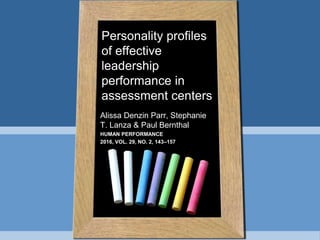Personality Profiles of Effective Leadership
- 1. Alissa Denzin Parr, Stephanie T. Lanza & Paul Bernthal HUMAN PERFORMANCE 2016, VOL. 29, NO. 2, 143–157 Personality profiles of effective leadership performance in assessment centers
- 2. Background • Most research examining the relationship between effective leadership and personality has focused on individual personality traits. • The present study sought to characterize different classes of leaders based on their personality profile and to determine how these classes relate to unique performance criteria measured in an assessment center
- 3. Research Questions • What different personality profiles can be identified in a sample of leaders? • What is the prevalence rate for each leadership profile? • How do these leadership profiles relate to various performance criteria measured in an assessment center?
- 4. Methodology • Descriptive and investigative study, no hypothesis. • Using Latent Class Analysis (LCA) – categorizes individuals into latent subgroups based on multiple observed scores.
- 5. Methodology • Sample: – 2,461 executive-level leaders (e.g., directors, vice presidents) from various organizations across the United States. – Average of 14 years of experience in leadership roles – Male (75%) and White (80%)
- 6. Methodology • Measurement: – The Hogan Personality Inventory, which parallels the five-factor model of personality – Assessment Center with 11 performance competencies, factor analyzed into 3 factor: • Defining the Strategy • Executing the Strategy • Building Partnerships and Translating the Message.
- 7. Methodology • Measurement: – Defining the Strategy: • understanding financial information and business trends. • selecting strategies to drive organizational growth – Executing the Strategy: • making day-to-day decisions • driving plans to achieve goals • initiating change • building an environment in which change can occur
- 8. Methodology • Measurement: – Building Partnerships and Translating the Message: • communicating effectively • persuading others • coaching others • networking
- 9. Discussion • There are six different profiles of leaders: – Unpredictable Leaders with Low Diligence (Low in Emotional Stability, Agreeableness, and Conscientiousness) – Conscientious, Backend Leaders (High in Conscientiousness but low on Agreeableness and Extraversion . – Unpredictable Leaders (low Emotional Stability and Agreeableness) – Creative Communicators (high Extraversion and Openness to Experience but low Conscientiousness) – Power Players (high on all five personality traits) – Protocol Followers (high on Emotional Stability and Conscientiousness)
- 10. Discussion • Power Players, on average performed well on all performance factors. • Protocol Followers performed lower on Defining the Strategy and Executing the Strategy but moderately good at forging interpersonal relationships and developing others, but they do not have the skills needed to identify future directions for the organization and drive those changes.
- 11. Discussion • Creative Communicators excelled in Building Partnerships and Translating the Message but were less skilled in developing and implementing strategies. • Unpredictable Leaders did not perform as well in formulating and implementing strategies. • Conscientious, Backend Leaders were adept at developing and acting on strategies but did not excel at conveying the message or gaining mass appeal • Unpredictable Leaders with Low Diligence lacked skills in networking and communication
- 12. Implications • Many different personality compositions make up leaders, some of which are more effective than others. • The important personality patterns of leaders and their resulting performance can then be used as a supplement for personnel selection.
- 13. Implications • Screen out leaders who do not seem to fit the ideal personality profile for a specific position ïƒ combines data from measures of personality,behavior, experience, and motivation. • One leader may not always be appropriate. Rather, dual leadership may be more instrumental for the success of the organization.
- 14. Implications • Knowing to what personality class leaders belong may aid in identifying developmental opportunities for improving the leader’s skills. • Identify leaders with high potential who have not yet had the opportunity to demonstrate their skills
- 15. Limitations • Utilized assessment center ratings of performance, rather than on-the-job performance. • the reliabilities for the performance factors were lower than optimal • Sample were Executive-level leaders who had on average 14 years of experience ïƒ another sample of leaders with less tenure
















